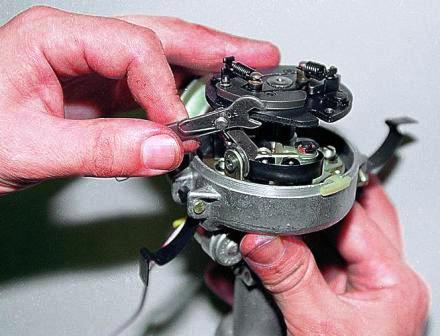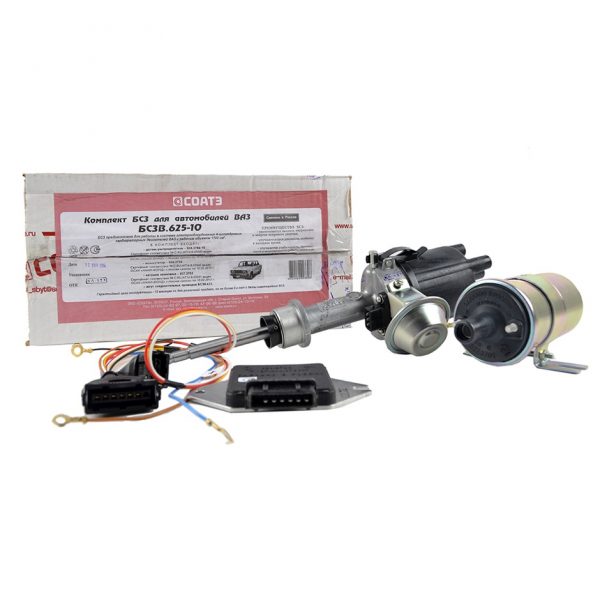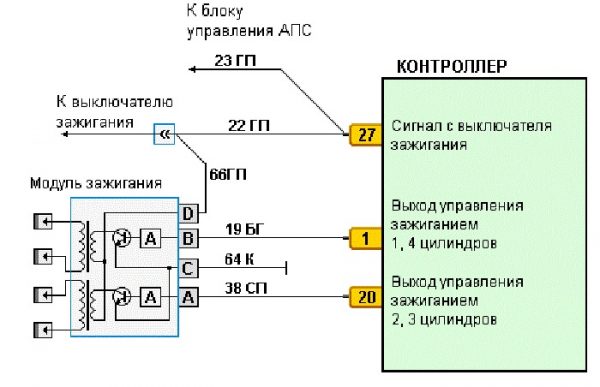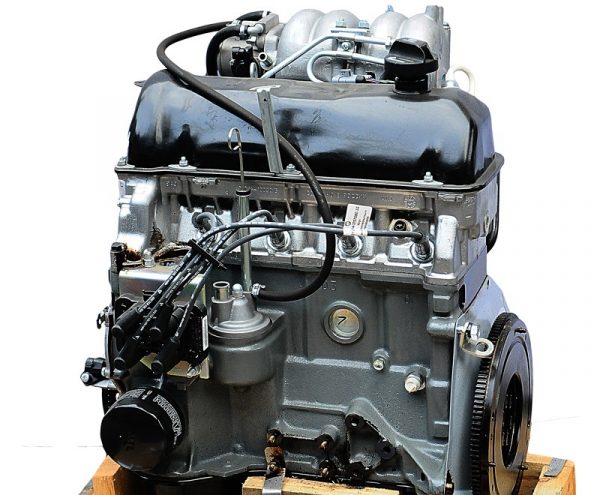
Self-diagnosis and replacement of the ignition module VAZ 2107
Content
The ignition system of the VAZ 2107 is one of the most vulnerable components of this car. However, all malfunctions can be easily diagnosed and eliminated independently.
Types of ignition systems VAZ 2107
The evolution of the VAZ 2107 has turned the ignition system of this car from an unreliable mechanical design into a modern computer-controlled electronic system. The changes took place in three main stages.
Contact ignition of carburetor engines
The first modifications of the VAZ 2107 were equipped with a contact-type ignition system. Such a system worked as follows. The voltage from the battery was supplied through the ignition switch to the transformer (coil), where it increased several thousand times, and then to the distributor, which distributed it among the candles. Since the voltage was applied to the candles impulsively, a mechanical interrupter located in the distributor housing was used to close and open the circuit. The breaker was subjected to constant mechanical and electrical stress, and it often had to be adjusted by setting the gaps between the contacts. The contact group of the device had a small resource, so it had to be changed every 20–30 thousand kilometers. However, despite the unreliability of the design, cars with this type of ignition can still be found today.

Contactless ignition of carburetor engines
Since the beginning of the 90s, a contactless ignition system was installed on carburetor VAZ 2107, where the breaker was replaced with a Hall sensor and an electronic switch. The sensor is located inside the ignition distributor housing. It reacts to the rotation of the crankshaft and sends a corresponding signal to the switching unit. The latter, based on the data received, supplies (interrupts the supply) voltage from the battery to the coil. Then the voltage returns to the distributor, is distributed and goes to the spark plugs.

Contactless ignition of injection engines
The latest VAZ 2107 models are equipped with electronically controlled injection engines. The ignition system in this case does not provide for any mechanical devices at all, even a distributor. In addition, it does not have a coil or a commutator as such. The functions of all these nodes are performed by one device - the ignition module.
The operation of the module, as well as the operation of the entire engine, is controlled by the controller. The principle of operation of such an ignition system is as follows: the controller supplies voltage to the module. The latter converts the voltage and distributes it among the cylinders.
Ignition module
The ignition module is a device designed to convert the direct voltage of the on-board network into electronic high-voltage impulses, followed by their distribution to the cylinders in a certain order.

Design and operation
The design of the device includes two two-pin ignition coils (transformers) and two high-voltage switches. The control of the voltage supply to the primary windings of the transformer is carried out by the controller based on the information received from the sensors.

In the ignition system of an injection engine, voltage distribution is carried out according to the principle of an idle spark, which provides for pairwise separation of cylinders (1-4 and 2-3). A spark is formed simultaneously in two cylinders - in the cylinder in which the compression stroke is coming to an end (working spark), and in the cylinder where the exhaust stroke begins (idle spark). In the first cylinder, the fuel-air mixture ignites, and in the fourth, where the gases burn out, nothing happens. After turning the crankshaft half a turn (1800) the second pair of cylinders enters the process. Since the controller receives information about the exact position of the crankshaft from a special sensor, there are no problems with sparking and its sequence.
Location of the ignition module VAZ 2107
The ignition module is located on the front side of the cylinder block above the oil filter. It is fixed on a specially provided metal bracket with four screws. You can identify it by high-voltage wires coming out of the case.

Factory designations and characteristics
VAZ 2107 ignition modules have catalog number 2111–3705010. As an alternative, consider products under the numbers 2112–3705010, 55.3705, 042.3705, 46.01. 3705, 21.12370–5010. All of them have approximately the same characteristics, but when buying a module, you should pay attention to the engine size for which it is intended.
Table: Ignition Module Specifications 2111-3705010
| Name | Index |
| Length, mm | 110 |
| Width | 117 |
| Height, mm | 70 |
| Mass, g | 1320 |
| Rated voltage, V | 12 |
| Primary winding current, A | 6,4 |
| Secondary winding voltage, V | 28000 |
| Spark discharge duration, ms (not less than) | 1,5 |
| Spark discharge energy, MJ (not less than) | 50 |
| Operating temperature range, 0С | from -40 to + 130 |
| Approximate price, rub. (depending on manufacturer) | 600 – 1000 Feet |
Diagnostics of malfunctions of the ignition module of injection VAZ 2107
The ignition of the injection VAZ 2107 is completely electronic and is considered quite reliable. However, it can also cause problems. The module plays an important role in this.
Signs of a malfunction of the ignition module
Symptoms of a failed module include:
- fire on the instrument panel signal lamp Check engine;
- floating idling speed;
- tripping of the engine;
- dips and jerks during acceleration;
- change in the sound and color of the exhaust;
- increased fuel consumption.
However, these signs can also appear with other malfunctions - for example, with fuel system malfunctions, as well as with the failure of some sensors (oxygen, mass air flow, detonation, crankshaft position, etc.). If the engine starts to work incorrectly, the electronic controller puts it into emergency mode, using all the resources that are available. Therefore, when changing the operation of the engine, fuel consumption increases.
In such cases, you should first of all pay attention to the controller, read information from it and decipher the error code that has occurred. This will require a special electronic tester, available at almost any service station. If the ignition module fails, the error codes in the engine operation may be as follows:
- P 3000 - no sparking in the cylinders (for each of the cylinders, the code may look like P 3001, P 3002, P 3003, P 3004);
- P 0351 - an open in the winding or windings of the coil responsible for cylinders 1-4;
- P 0352 - an open in the winding or windings of the coil responsible for 2-3 cylinders.
At the same time, the controller can also issue similar errors in the event of a malfunction (break, breakdown) of high-voltage wires and spark plugs. Therefore, before diagnosing the module, check the high voltage wires and spark plugs.
The main malfunctions of the ignition module
The main malfunctions of the VAZ 2107 ignition module include:
- open or short to ground in the wiring coming from the controller;
- lack of contact in the connector;
- short circuit of the windings of the device to ground;
- break in the module windings.
Checking the ignition module
To diagnose the injection module VAZ 2107, you will need a multimeter. The verification algorithm is as follows:
- Raise the hood, remove the air filter, find the module.
- Disconnect the block of the wiring harness coming from the controller from the module.
- We set the voltage measurement mode on the multimeter in the range of 0–20 V.
- Without starting the engine, turn on the ignition.
- We connect the negative (usually black) probe of the multimeter to the “mass”, and the positive one to the middle contact on the harness block. The device must show the voltage of the on-board network (at least 12 V). If there is no voltage, or it is less than 12 V, the wiring or the controller itself is faulty.
- If the multimeter shows a voltage of at least 12 V, turn off the ignition.
- Without connecting the connector with wires, disconnect the high-voltage conductors from the ignition module.
- We switch the multimeter to the resistance measurement mode with a measurement limit of 20 kOhm.
- To check the device for a break in its primary windings, we measure the resistance between contacts 1a and 1b (the last ones in the connector). If the device resistance tends to infinity, the circuit really has an open circuit.
- We check the module for a break in the secondary windings. To do this, we measure the resistance between the high-voltage terminals of the first and fourth cylinders, then between the terminals of the second and third cylinders. In working condition, the module resistance should be about 5–6 kOhm. If it tends to infinity, the circuit is broken and the module is faulty.
Video: checking the ignition module VAZ 2107
Replacing the ignition module VAZ 2107
In the event of a malfunction, the ignition module should be replaced with a new one. Repair is possible only if the breakdown does not consist in a break or short circuit of the windings, but in a visible violation of any connection. Since all conductors in the module are aluminum, you will need special solder and flux, as well as some knowledge of electrical engineering. At the same time, no one will give guarantees that the device will work flawlessly. Therefore, it is better to buy a new product worth about a thousand rubles and be sure that the problem with the ignition module has been resolved.
Even an inexperienced motorist can replace the module on his own. Of the tools, you only need a hex key for 5. Work is performed in the following order:
- Open the hood and disconnect the negative terminal from the battery.
- Removes the air filter housing, find the ignition module and disconnect the high voltage wires and the wiring harness block from it.
- Unscrew the four screws securing the module to its bracket with a 5 hexagon and remove the faulty module.
- We install a new module, fix it with screws. We connect high-voltage wires and a block of wires.
- We connect the terminal to the battery, start the engine. We look at the instrument panel and listen to the sound of the engine. If the Check engine light goes out and the engine runs stably, everything is done correctly.
Video: replacing the ignition module VAZ 2107


Watch this video on YouTube
Thus, it is quite simple to determine the malfunction and replace the failed ignition module with a new one with your own hands. This will require only a new module, a 5 hexagon and step-by-step instructions from specialists.

